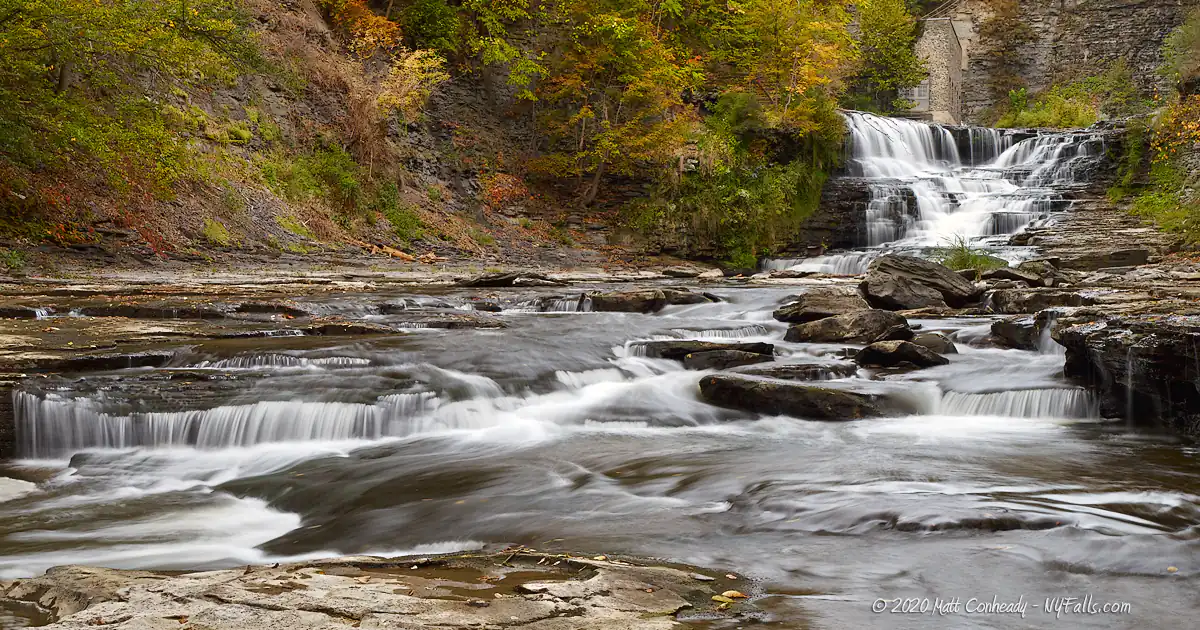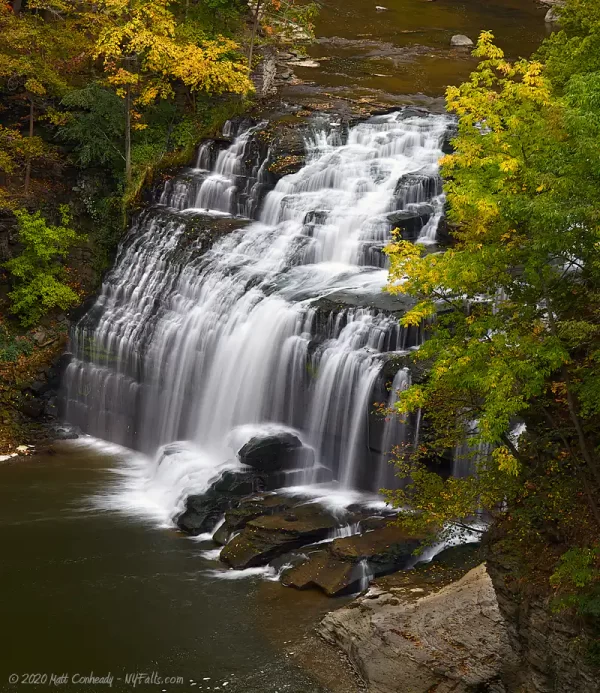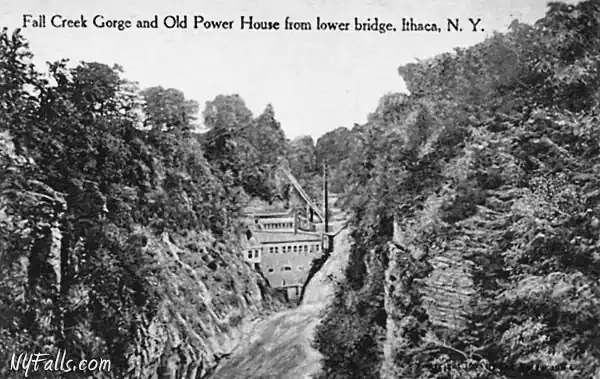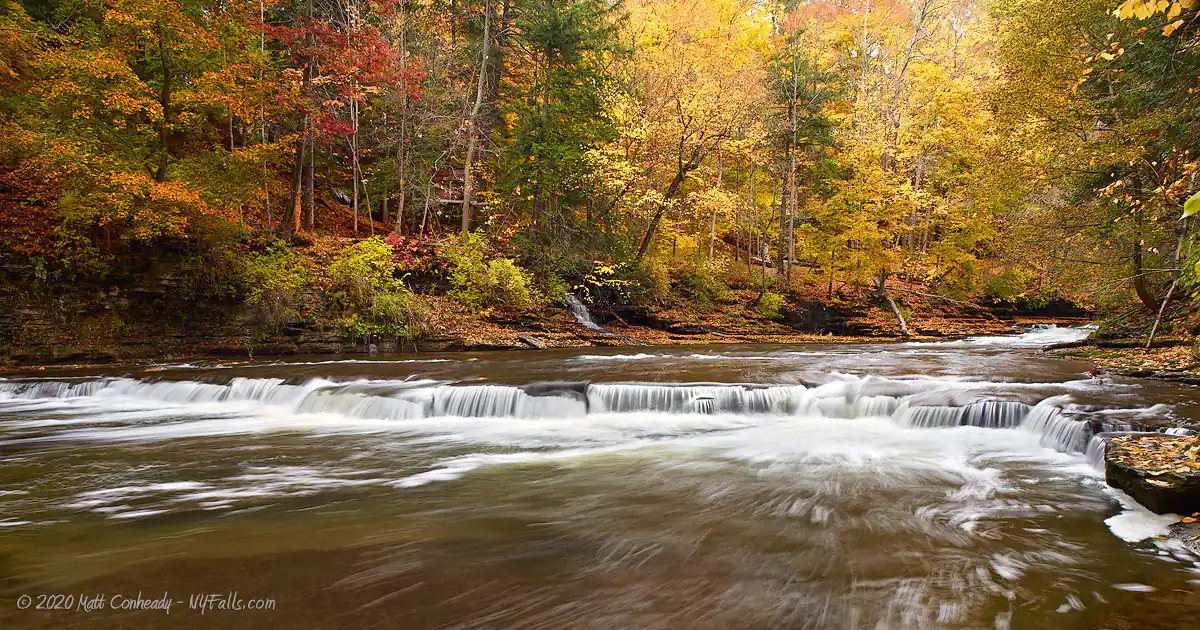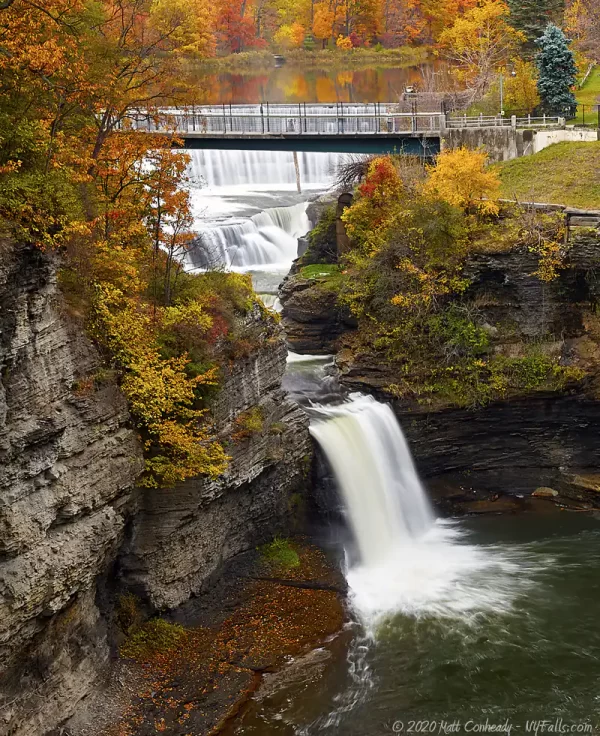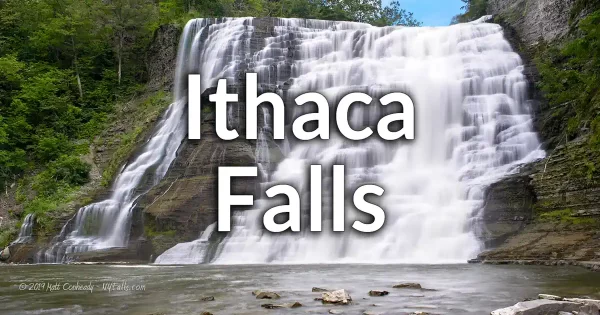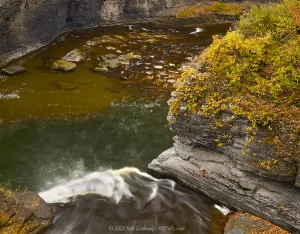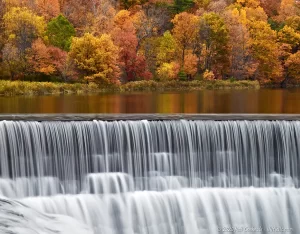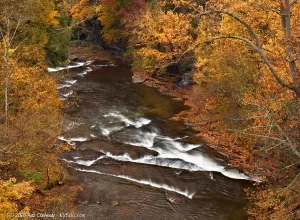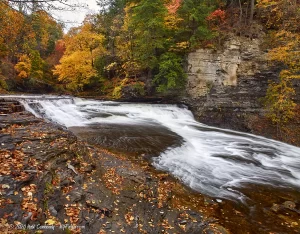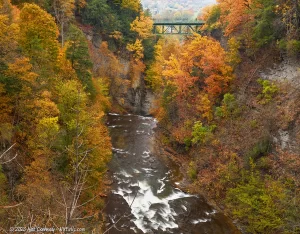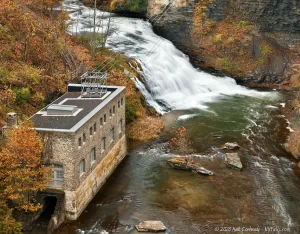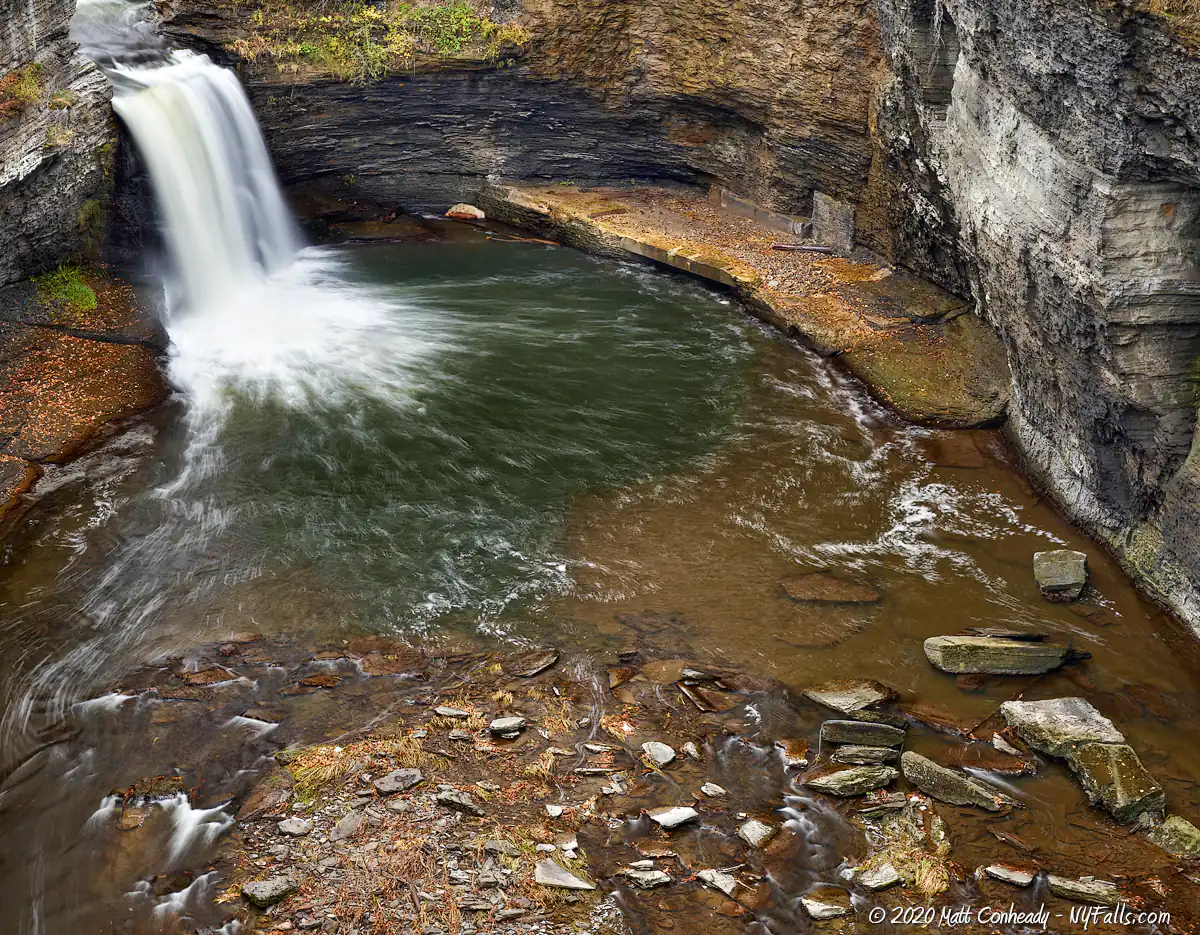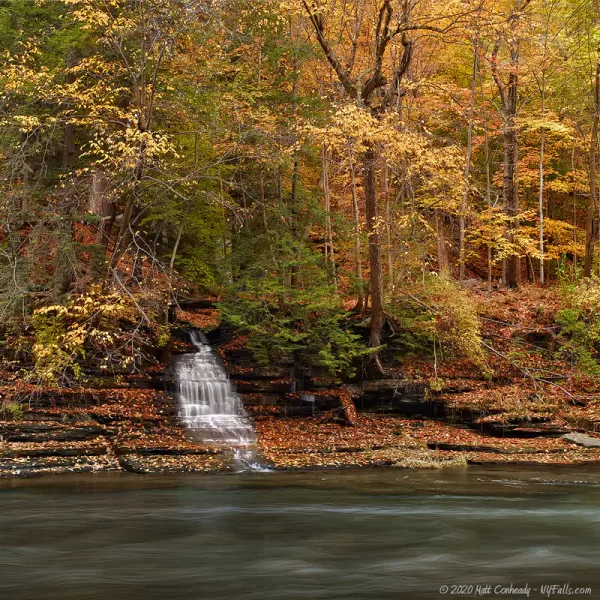Fall Creek Gorge – Ithaca
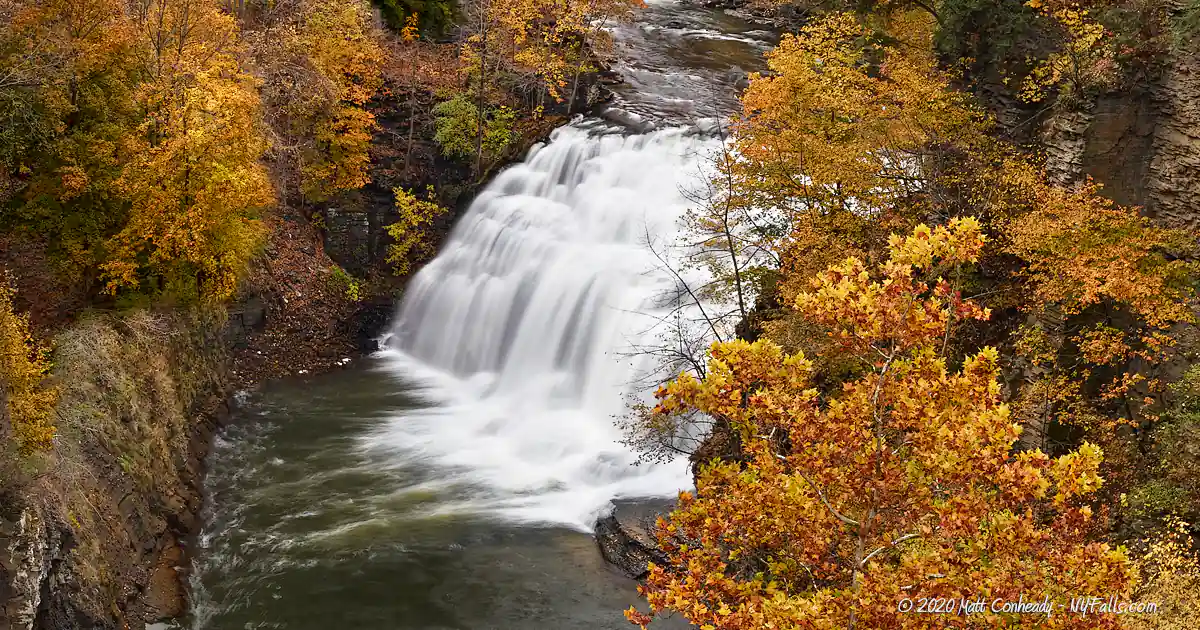
Location: City of Ithaca; Tompkins County; Finger Lakes Region; New York
Maps: Google Map; Topographic; Trail Map; Interactive.
GPS Coordinates:
- West parking lot: N 42.45244 / W 76.48564
- Trailhead on Stewart Ave: N 42.45208 / W 76.48972
- East parking lot near Beebe Lake: N 43.16892 / W 78.69493
Directions: Located on the north side of the City of Ithaca, right in the middle of Cornell University Campus. Use these Google Map directions to get you to the parking lot on the east side of the gorge (for a hike upstream) or these to get to the parking lot at Beebe Lake for a hike downstream.
Parking: There are parking lots all around the campus, but one has to be careful as they are not all open to the public. The Cornell Botanical Gardens trail system has a few lots designated for public use. A small lot is located on the north end of the gorge, about half-way up the gorge, off of Fall Creek Drive (near the pedestrian bridge).
Another, on the south end of the gorge, is a part of the University but does have some spots not dedicated to campus use. Check and obey the signs. It is located on the east end near the Beebe Lake dam. You could go with either one. The path I recommend loops around to both. Lots may get full on summer weekends.
Weather
Information / Accessibility / Accommodations
Number of falls: 4 waterfalls in the gorge between Ithaca Falls and Lover’s Falls (at the end of Beebe Lake).
Size/Types: From east to west:
- Forest Falls is a 55 ft cascade flanked by high cliff walls.
- Foaming Cascade is 20 ft high with a concave crest. It is often referred to as Horseshoe Falls.
- Rocky Falls is just under 30 ft high and the widest of the falls. It hugs a bend in the creek.
- Triphammer Falls is about 56 ft high in total. The upper quarter is a man-made dam that holds back Beebe Lake. The lower 3/4 is a set of natural cascades that empty into the corner of an open gorge.
Best time to visit: Spring through fall.
Flow: Usually high. The currents can get pretty dangerous. View the page on safety.
Waterway: Fall Creek. Fall Creek starts out in the hills south of Skaneateles Lake, about 24 miles to the northeast. Once it passes through the gorge, it empties into the south end of Cayuga Lake.
Time: A few hours.
Seasons/Hours: Daylight hours.
Admission: Free.
Handicap Accessibility: Paved walkways on the southern end of the gorge are the best route. The Stewart Ave Bridge, Thurston Ave Bridge, Suspension Bridge, and the Cornell Plantations walkway all cross the gorge and offer excellent views. The side trails that tip down into the gorge are not accessible.
Pets: Allowed on premises with a leash.
Accommodations: The trails surrounding the gorge are connected to a more extensive trail network extending east along the creek. Unfortunately despite the campus being right there, you won’t find any public restrooms or picnic facilities here. For a variety of shops, restaurants, and a public restroom, hop in a car and head 2 miles southeast to Ithaca Commons.
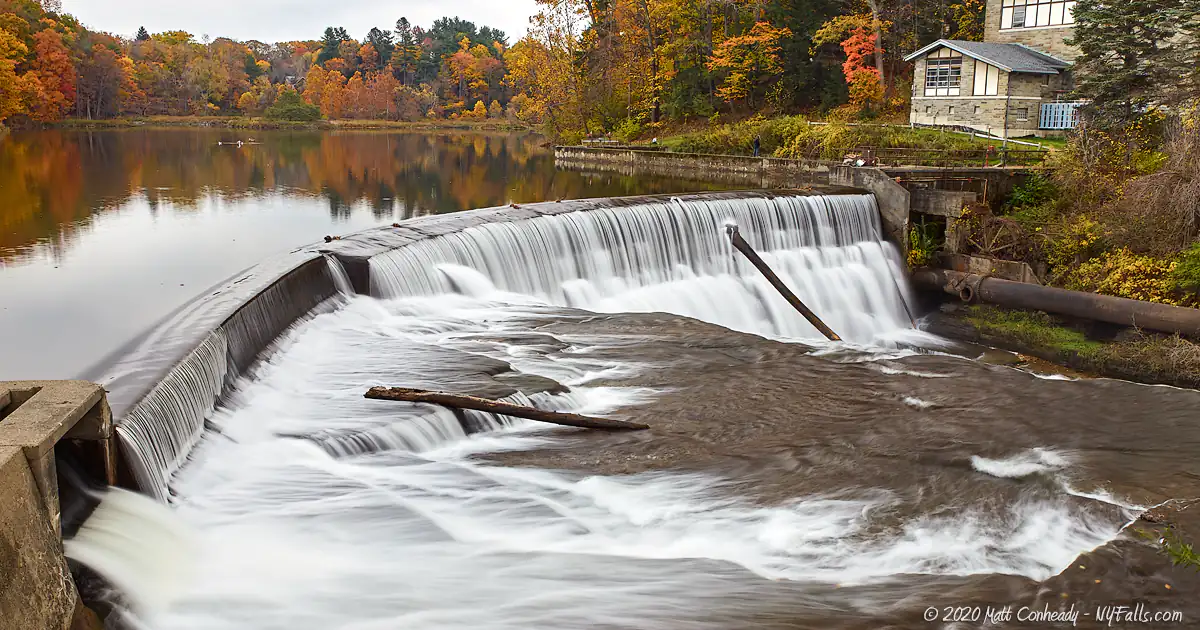
Description
One of the grandest gorges of the Finger Lakes, and certainly the largest in the city of Ithaca, Fall Creek Gorge is a natural oasis in the well-developed and often humming campus of the adjacent Cornell University. Cornell’s origins started in this hanging valley, where its founder worked as a carpenter refurbishing various mills that tapped its waters. Today, the University uses portions of the stream as water power and acts as a steward for its preservation and study.
This page covers only 4 of the 6 waterfalls along this length of Fall Creek. From above Ithaca Falls to Triphammer Falls, this stretch of the gorge harbors massive waterfalls below the gorge’s steep cliffs that almost completely isolate it from the traffic above. Dotted with mysterious tunnels, crumbling mill foundations, and other various scars from its past industries, it has since regressed far back to a pleasant natural state. When the trail dips down close to water level, it does feel like another world as the sound of rushing water takes over, and it’s easy to forget you are in the middle of a city of 31,000.
By crossing through campus, visitors are treated to views of the falls from the trails above, with an offshoot or two dipping down into the gorge. There are no opportunities to walk in the creek, swim below the falls, or do any climbing—and that’s okay. Even from afar, it’s a breathtaking experience. You can get awfully close to the thumping waters of Triphammer Falls, which once featured an intriguing abandoned hydraulic plant. Photos of the falls rushing past the crumbling brick and rusted pipes were once iconic of Ithaca’s gorges. The building has been removed in recent years, and to be fair, the sight of the water plunging into a now pristine canyon looks just as awesome. My pick for the best waterfall in Fall Creek is easily Forest Falls, which is seen from the Stewart Avenue bridge. In autumn its model form is framed by vibrant foliage and towering serrated cliffs, serving as a sentry for the rest of the gorge. I consider it to be one of the most photogenic waterfalls in Upstate New York.
Unfortunately, Fall Creek is a dangerous one. A combination of factors have led to a history of tragedy in the gorge and especially the waters below each cascade. The flow can often be turbulent, especially in early spring or in flash flood conditions. While swimming below the falls used to be a Cornell tradition, it’s prohibited due to periodic drownings. The steep cliffs and difficult access to the gorge below have also led to persons falling with serious injury and death. We also cannot ignore another serious problem: surrounded by a competitive Ivy-League school, this gorge is no stranger to victims of suicide. In recent years, tall fences and other physical safety installations have been added to bridges over the gorge. Memorials dot the gorge and serve as poignant reminders to be safe, to seek and offer help, and to live on in order to experience other marvelous natural beauties such as this.
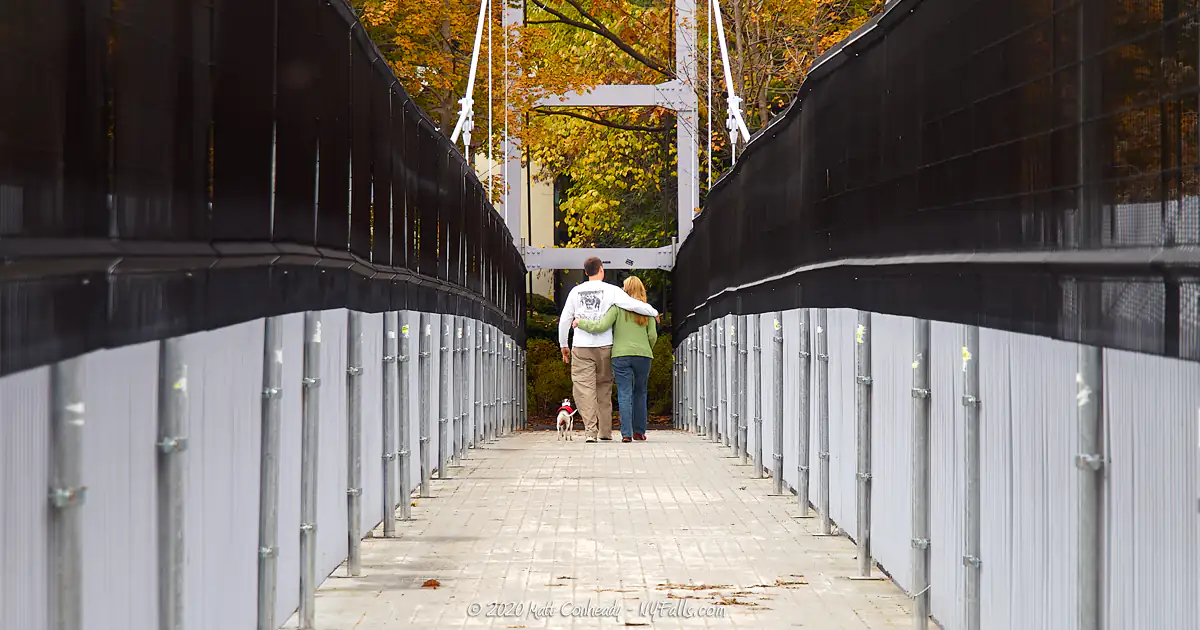
History
Beebe Lake is named for Jeremiah Sullivan Beebe (1790-1861) a land agent from New York City who settled in Ithaca in 1817. He was a shopowner, property owner, miller (in Fall Creek Gorge), manufacturer, banker, hotel owner, and Ithaca Town Supervisor.
As with most gorges and waterfalls in the region, Fall Creek Gorge’s modern history begins with the milling industry. In 1830 J.S. Beebe hired a young carpenter by the name of Ezra Cornell (from the Bronx, New York) to repair one of his several mills in the gorge. They worked together afterward to construct a mill race tunnel into the gorge above Ithaca Falls to make the gorge more suitable for powering mills. Ezra eventually handled all of Beebe’s concerns in and around the gorge.
Around 1842, Ezra Cornell developed and patented a unique plow capable of digging ditches perfectly suitable for laying telegraph cables. As the new communication industry boomed, Ezra made a fortune from constructing telegraph infrastructure in Upstate New York. One of his ventures eventually went on to become Western Union. In 1862 he became a member of the NYS Assembly, then a member of the NYS Senate in 1864.
As a retiree, he established the Cornell Free Library in 1866. He continued with promoting education and contributing to the local community. Cornell offered his adjacent farmland in Ithaca as well as $500,000 of his personal fortune to found the University.
In 1892 the University installed water wheels at Rocky Falls, where the modern power plant exists today. The power operated machinery at the Sibley College of Mechanical Engineering and also powered lights around campus. It was replaced with a modern structure again in 1904, which was again replaced with the current one in 1981.
Once a forested swamp, the valley above Triphammer Falls was dammed in 1838 turning the swamp into a lake 18 ft deep. A larger dam was constructed in 1898 raising the lake levels 10 additional feet.
In 1898 the University’s College of Civil Engineering built a hydraulics laboratory alongside Triphammer Falls. It was used to study water purification and flow. It was expanded in 1901. After taking severe damage from flooding in the 1960s it was left abandoned and crumbling. In February of 2009, a part of the structure collapsed and it was decided that the rest of it would be removed later that year.
In 1990 Fall Creek Forge was designated a New York State Recreational River. What does that mean? It means it’s mostly protected from development and misuse.
Hiking / Walking Trails
Difficulty: Easy. Some offshoots of the trail have steps. Most of it is paved, but uneven. There are some steps, but they are avoidable.
Markings: There’s a mix of Orange and Red Blazes along the way. Some parts have no markings. It’s best to use a map and pay attention to where you are going.
Distance: About a mile one way. Two if you want to make a loop.
Trail Guide:
There are a few ways to walk along the gorge here. I’m going to outline the path I take. I usually park in the small lot off of Fall Creek Drive, near the suspension bridge. Instead of crossing the bridge, I head back to Fall Creek Drive and follow that west to the Stewart Ave bridge. From there, Forest Falls is visible from the bridge.
At the southeast corner of the Stewart Ave bridge, there is a trailhead that leads into a wooded area. The blazes on the trees are red. This path hugs the south rim and has an offshoot that leads down into the gorge for a close view of Foaming Falls and Rocky Falls. This offshoot is closed in winter and whenever there’s a risk of flooding. Head back up to the wooded rim trail and continue left until you reach the suspension bridge.
Head out onto the pedestrian bridge to get a view of Foaming (Horseshoe) Falls below and a small power plant further upstream. You can also see Rocky Falls poking out of the bend just beyond the plant. You could cross the bridge to get back to your car, but we aren’t done yet. Head back south and then turn left to climb some stairs to University Ave.
Once at street-level on University Ave, continue east through the campus, past the Foundry building, to the Thurston Ave bridge. Head out on the bridge to get a view of Triphammer Falls. Instead of crossing the bridge, head back south and head left at the intersection (continuing the direction you were previously headed). University Ave is not Forest Home Drive.
The sidewalk veers off to the left into a wooded area. Follow this for 100 feet until you reach an intersection with another paved walkway. Turn left to go to the pedestrian bridge above Triphammer Falls. From here you can see the Beebe Lake dam and Triphammer Falls.
To get back to the car, you can backtrack to the suspension bridge and cross that to get to the parking lot. I like to continue north from the dam, and loop back through the campus walkways to Fall Creek Drive. See the path I take on the Interactive Map below.
Map: Interactive.
Fall Creek Gorge Interactive Map
Explore More
Ithaca Falls Natural Area
Yes, it is technically a part of the Fall Creek Gorge, but not only is it accessed from a different location, its beauty and interesting history also warranted its own page. If you are visiting Fall Creek Gorge, I highly recommend carving out some time to visit Ithaca Falls as well. From the Stewart Ave Bridge highlighted in the Trail Guide here, you can look west to see an old dam above Ithaca Falls. Just beyond that is the crest of the falls itself. You could walk some steep roads to get to the Ithaca Falls parking area from here, but I recommend just driving.
Ithaca’s Fall Creek Gorge Media
Interesting Stuff
Cornell Heights Historic District
This National Historic District is the neighborhood north of the gorge. It consists of 208 early 19th-century buildings and serves mostly as residences for faculty at Cornell University. Of note is 900 Stewart Ave, the former residence of Carl Sagan. The planned prominent residential district has an abundance of Colonial Revival, Craftsman, and Tudor Revival style homes.
Beebe Lake Natural Area
Cornell Botanic Gardens Beebe Lake Natural Area features a 1-mile trail around the lake, with a waterfall in Hemlock Gorge on the eastern inlet. They Cayuga Trail extends this network miles to the east, following the meandering creek along the way. This is a massive set of trails that could easily take a whole day to explore. Map.
Photography Tips
There’s more than the big falls
- With the massive cliffs, twists and turns, mill ruins, and small tributaries leading into the gorge, keep an eye out for the smaller, most often overlooked scenes. Since you will be shooting from the top of the gorge, packing a lens with reach will help.
Ithaca
- From the Stewart Ave Bridge, you can see the valley below. Catch sunsets here in late summer.
Fences
- Due to safety concerns, tall chain link fences and catches were installed on bridges and other accessible areas of the gorge. While initially this inhibited photography, someone cut larger holes into them for a better view. Still, those massive lenses may not fit well through them. When shooting, always be mindful of barriers in the edges of your shot.
Summer Mornings
- Early summer weekend mornings are the best times to visit. You don’t have to worry about low flow in Fall Creek most summers. Cornell traffic should be low.
Silky Water Effect
- To get that smooth cotton-candy look to the falls, you need to use a Neutral Density (ND) filter on your lens. The ND filter will block some of the light from entering the lens without altering the color, and thus allows your shutter to stay open longer. This blurs the water and creates a soft white gloss to the foamy areas of the falls. Check out the article for all of the details.
More tips
- See the Articles for more photography tips.
10 Must-Visit Waterfalls Around Ithaca, NY
A selection of the most popular and accessible waterfalls around Ithaca in the Finger Lakes Region of New York.
Who to Contact
Tompkins County Parks and Trails Network
[email protected]




